Thailand is a Southeast Asian country that is well-known for its beautiful beaches, opulent palaces, and ancient Buddha temples. The people there mainly speak in Thai, with English rarely being used beyond the classrooms. Also, social media and other digital technologies are quickly becoming a part of the Thai people’s everyday lives.
As of the moment, Thailand is experiencing a huge growth of online consumers. Currently one of the leading countries in internet and mobile internet usage, a majority of Thailand’s youth and middle-aged people have access to the internet through their mobile devices. The country’s digital market is also expected to grow rapidly by the year 2020. With Thailand’s high digital penetration rates and the prospective digital marketing industry, there are a lot of opportunities available for those who wish to make the most out of the country’s online market.
This article will discuss Thailand’s digital marketing environment, its biggest channels, industry trends and opportunities, successful campaigns, and the best possible ways on how to reach the Thai audience.
Thailand’s Digital Marketing Landscape
Recognized by the World Bank as “one of the great development success stories”, Thailand’s smart economic policies have brought it from a low-income to an upper-income nation in just a span of a few decades. And with the recent implementation of the economic model entitled “Thailand 4.0”, engaging in business within the country is encouraged now more than ever.
According to We Are Social’s Digital Report in 2020for Thailand, there are 69.71 million people residing in the country, with 50% living in urbanized areas. Moreover, 134% or 93.39 million of the population have mobile subscriptions, increasing by 0.9% since last year. Within the 52 million internet users, 51 million are active social media users and 52 million are mobile social media users. This would mean that the majority of the country’s social media users use mobile devices to access social media sites.
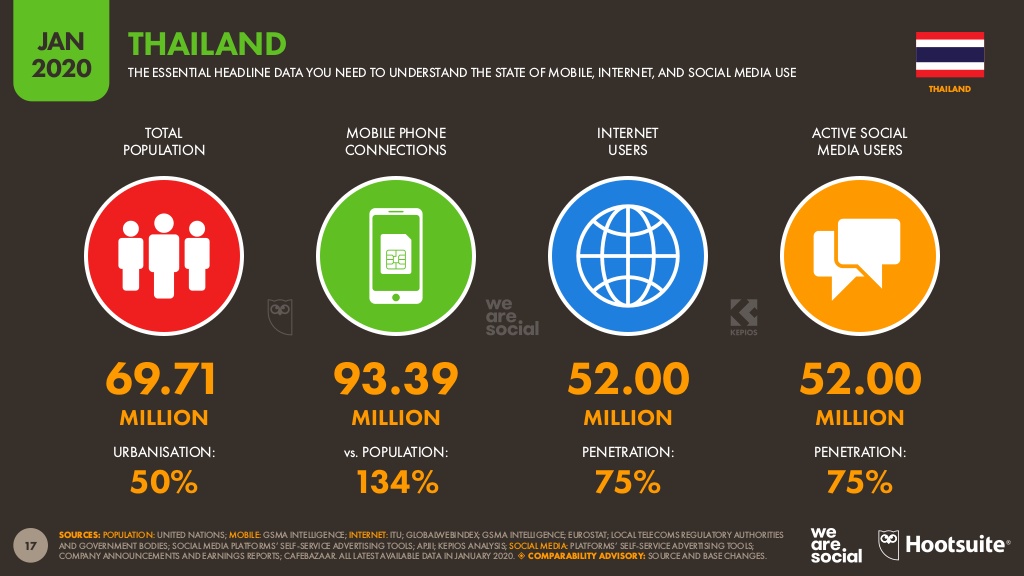
Source: https://datareportal.com/reports/digital-2020-thailand
Internet users spend about an average daily time of 9 hours and 1 minute online, with one-third of the time spent on using social media. The social media platforms that are visited the most are Facebook with 94%, Youtube with 94%, and Line with 85%. Facebook Messenger and Instagram, however, are slowly catching up this year with 76% and 65% respectively. Those who use the internet have an average of about 10.1 social media accounts.
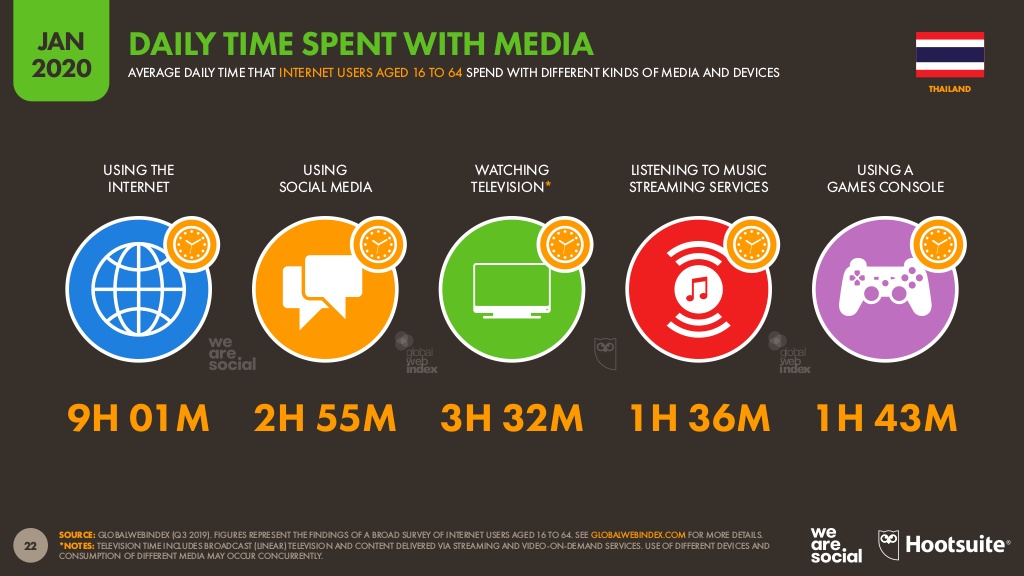
Source: https://datareportal.com/reports/digital-2020-thailand
It should be noted that 94% of Thailand’s adult population use mobile phones, and 94% of them use smartphones. Out of this, 97% have broadband mobile connections. This entails that Thai people use their mobiles for various online purposes. With a majority of Thais using mobile phones to access the internet, it is best that digital marketers should focus on developing strategies that are mobile-friendly.
Thailand is also an ideal country for e-commerce businesses. It is currently leading in the global rank of mobile banking with 65%, 35% higher than the global average. They are also second in the global ranking in ownership of cryptocurrency and third in mobile commerce. Thai people’s monthly e-commerce activities are divided as such: 90% search online for a product/service to buy, 85% visit an online retail store, and 82% purchase a product/service online.
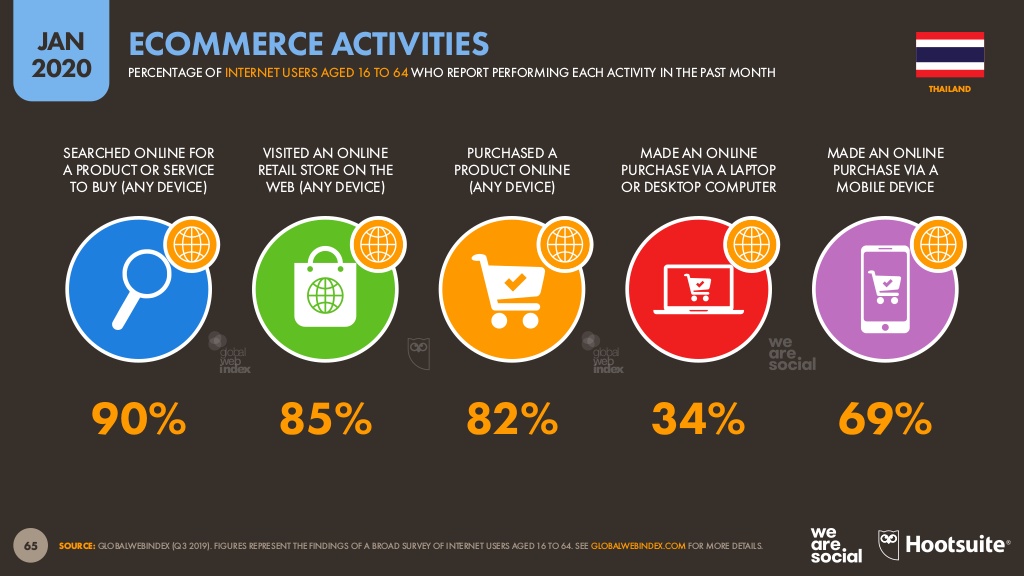
Source: https://datareportal.com/reports/digital-2020-thailand
Biggest Channels
Social networking giants such as Facebook, YouTube, and Line dominate the country’s most active social media platforms. Here are some statistics and insights on each social media platform:
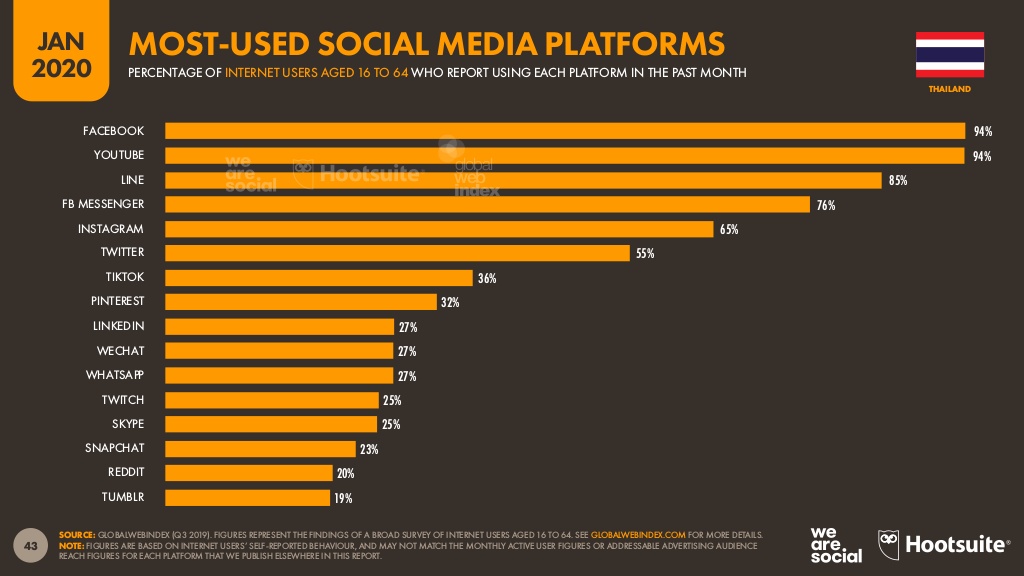
Source: https://datareportal.com/reports/digital-2020-thailand
Facebook is a social media giant with over 2.5 billion active accounts reported just this year. In line with this, Thailand has over 47 million Facebook users, ranking eighth worldwide in terms of usage of the social media platform. This brings the usage of the social media platform in the country to a 94% rate.
When it comes to using Facebook, both sexes are equally reached by adverts. In fact, 79% of Thais over 13 years old can be reached by adverts. Additionally, these three Facebook content formats have had the highest number of engagements in the past year: video posts by 9.52%, photo posts by 4.15%, and page link posts by 3.16%.
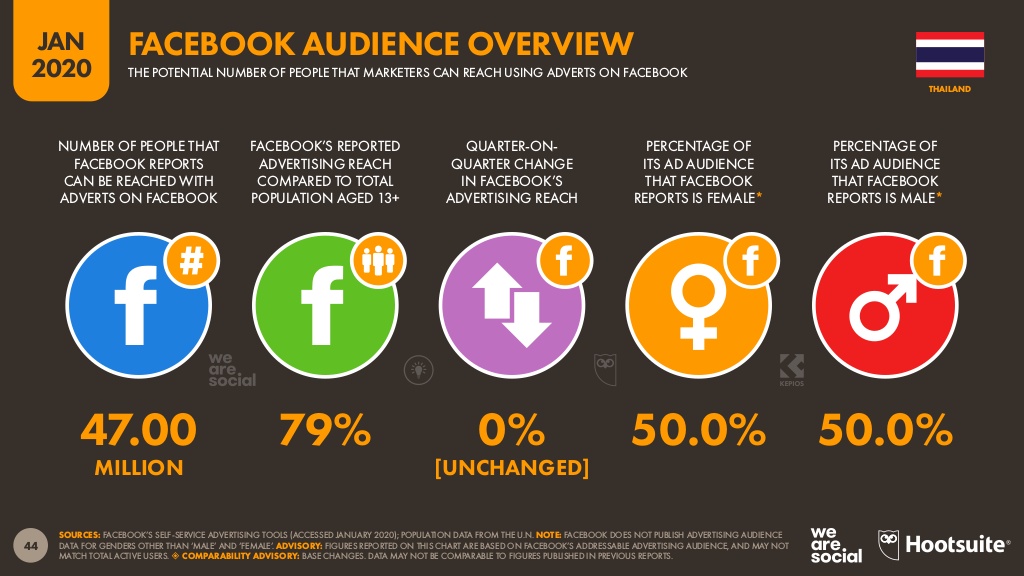
Source: https://datareportal.com/reports/digital-2020-thailand
In terms of page reach, the average monthly change in page likes is 0.09%. With the average post reach being 8.1% and the organic reach idling at around .5.2%, 23.4% of Facebook pages use paid media to boost their posts. Thus, the total reach of pages is 32.7%.
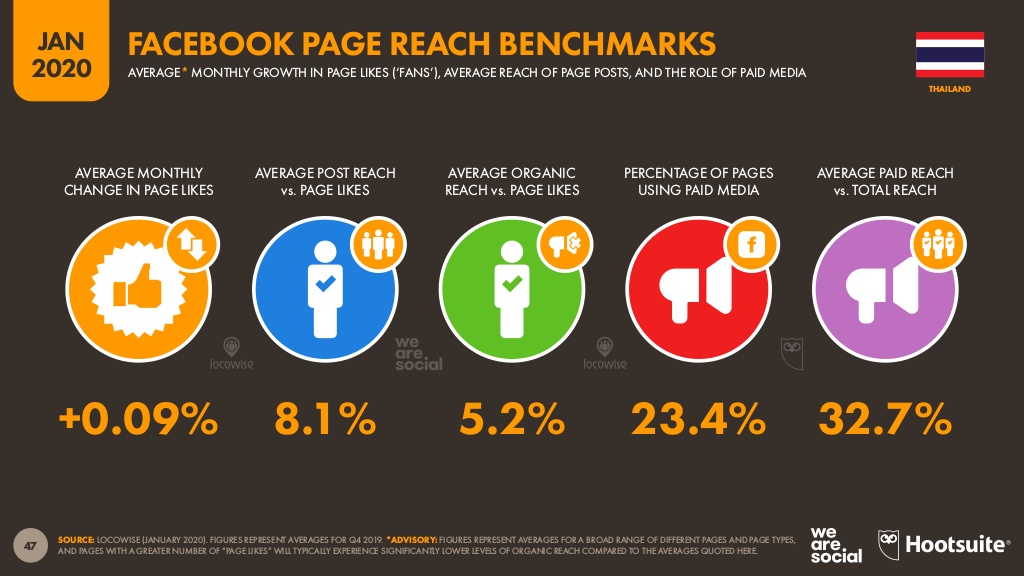
Source: https://datareportal.com/reports/digital-2020-thailand
YouTube
YouTube currently sits in 2nd place as the most active social network platform in Thailand. As 99% of Thai internet users spend time watching videos online, 53% of them do so on YouTube. Over a total of 46 million Thais watch YouTube.
In addition to this, 94% of Thai internet users accessed the platform daily in 2020. Thai people spent an average of 29 minutes and 9 seconds a day. On the Alexa website, it has been calculated that the platform receives the second-highest traffic from search engines per month. Each visitor on the platform also has an estimated amount of 8.6 daily pageviews.
Line
Currently, Line is Thailand’s biggest messenger platform, dominating over Facebook Messenger by 9%. There are over 44million Line users in Thailand, making the country the 2nd largest user of the app right after Japan. The app’s useful features, adorable characters, and marketing strategy of localizing the app have attracted Thai people of all ages. In fact, the app has expanded into different categories such as Line TV and Line Today to cater to the Thai audience’s needs.

Source: http://www.businessofapps.com/data/line-statistics/
Trends and Opportunities
Here are some of the several digital marketing trends in Thailand which may greatly help companies in their digital marketing strategy:
Online Shopping
In 2016, the Thailand government implemented an economic model named “Thailand 4.0” to improve Thailand’s digital market. This created an influx of opportunities for those who wish to delve into the country’s e-commerce businesses, as the program encourages businesses to utilize e-marketplaces and e-payments to sell their products and services.
Currently, electronics and travel are the product categories that have the highest e-commerce revenue. Fashion follows close with an annual amount of 1.03 billion US dollars. According to Statista, Thailand’s e-commerce revenue is 6,921million US dollars in 2020. By 2024, it is expected to rise to 11,266 million US dollars. With an annual growth rate of 13%, this is a good opportunity for businesses to get involved in the country’s digital market.
Over 38.4 million of the Thai populace shop online, with each individual spending an annual average of 356 US dollars. The majority of Thais who purchase goods online prefer credit cards as a method of payment, yet alternative online paying methods are starting to gain traction in the country. The variety of products sold online, from electronics to personal necessities, are expected to increase in the coming years. With this, online marketing is encouraged now more than ever.

Source: https://aseanup.com/wp-content/uploads/2017/11/shopee-thailand.jpg
Content Marketing
As one of the go-to marketing strategies for establishing your brand in the industry, content marketing is essential to connect with the Thai audience. As people find advertising and sales messages untrustworthy, digital marketers should turn to create culturally-relevant content to establish a relationship with the target audience.
Online content influences the Thais’ decisions. 85% of them search for the items online before making the purchase. Aside from creating a blog or website to share content with the Thai audience, video marketing can also be a way to easily distribute content to the public. With 94% of Thais use YouTube, it is important for marketers to consider delivering their content through videos.
Social Media Marketing
With smartphones being used all over the country, social media has become an avenue for Thai people to sell and buy products. In 2017, the country’s social commerce sales reached up to 10.9billion US dollars. Social and mobile shopping is forecasted to have an annual growth rate of 20% through 2025. Facebook and Instagram have over 10,000 online stores, making the two social media platforms one of the biggest e-commerce marketplaces in the country.
Over 40% of Thailand’s online shoppers use social networks to purchase products. With merchants being able to post details and images of products online, buyers can inquire and discuss directly with the seller about the product. An example of this is Nong, a Thai shop owner selling plus-sized apparel, who used Facebook’s live streaming and chat features to directly connect and answer viewer’s questions. By genuinely connecting with the viewers in real-time, she was able to encourage the audience to buy her products.

Source: https://asia.nikkei.com/Business/Business-trends/For-Thais-online-shopping-is-a-social-activity
Influencer Marketing
Since the majority of the Thai population are on social media, investing in influencers can be good for business. Influencer marketing is a marketing strategy that uses influencers to establish trust and interest in the product to the audience. With this strategy, influencers can act as a bridge of trust between brands and consumers.
In a survey made by Booking.com, it is found that 64% of Gen Z and 36% of millenials visualize their next travel destination from social media. 51% of Gen Z trust influences for travel recommendations. With that in mind, the study states that brand promotions should be melded with the entertaining and original content of the influencer to produce a “native content approach” to selling the product.
Programmatic Marketing
Programmatic marketing has become one of the leading methods of advertising on the web. The strategy may seem to look complicated to marketers at first, but it can be summed up in this manner: when an individual clicks on a webpage, the page’s publisher puts the ad view for auction at an ad marketplace, and the advertiser that bids the highest gets to have their ad posted on the website. This is especially useful for marketers who want to save up on ad spending.
With programmatic advertising gaining traction with the rest of the world, it’s no surprise that Thailand is also planning to utilize it in the future. In fact, 67% of the display revenue will go to programmatic advertising in the year 2022. With this efficient and cost-effective marketing strategy, programmatic marketing can be beneficial to digital marketers in Thailand.
Summary
Thailand is rapidly becoming digitalized due to “Thailand 4.0”. With over 52 million Thais having access to the internet in 2020, trends such as online shopping and social media influencers are big opportunities to take advantage of. With this in mind, digital marketers should start creating effective marketing strategies that can give them a leg-up in the still-developing digital market.
Contact us at Info Cubic Japan today to learn more about online marketing in Thailand.



